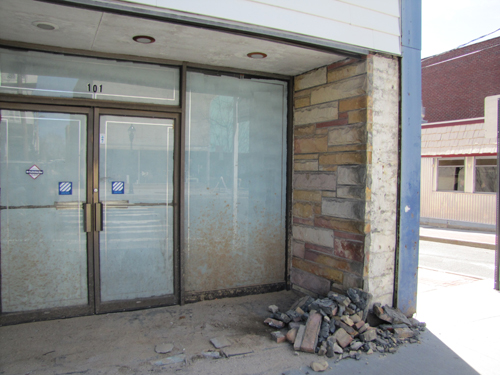Building owners may be required to decorate vacant storefronts

Riverhead Town may soon borrow a page from East Hampton Village in requiring owners of vacant stores in the downtown area to spruce up their windows with attractive displays, rather than just having an empty building or a window covered with newspapers.
The Town Board discussed the proposal at Thursday’s work session and is expected to schedule an Aug. 4 public hearing at their regular meeting Tuesday.
“Vacant or closed stores with unattractive and unmaintained storefront windows detract from commercial streetscapes,” the proposal states.
Councilwoman Jodi Giglio, who is proposing the new law, said it’s based on a law passed in East Hampton Village in 2012.
The proposal would give owners of vacant buildings 30 days to apply for a permit to put up a sign or display in their Downtown Center-1 zoned storefronts, which generally spans from Ostrander Avenue to Griffing Avenue. That would be more “aesthetically pleasing” than having the window fogged over, covered with paper or just left empty, according to Ms. Giglio.
The signs or displays would be set back at least four feet from the window.
“Within that four-foot area, you would have some sort of aesthetic or artistic display to look at that’s a pleasant visual when you walk by an empty storefront,” Ms. Giglio said in an interview.
The East End Arts Council in recent years held a contest in which groups decorated the inside of vacant buildings on Main Street around Christmas, Ms. Giglio said. She’s hoping the art council will be involved in helping vacant store owners decorate their windows.
“A lot of places throughout the country do this,” said Ray Pickersgill, the president of the downtown Business Improvement District Management Association, who said he favors the proposal to spruce up vacant buildings.
“I belong to a group called National Historic Main Streets, and we get a magazine that tells all the different laws around the country,” he said. “In some places, they give you a year to rent your building, and if you don’t rent it, they increase your taxes, so they won’t have vacant buildings.”
Mr. Pickersgill said the town should also require vacant buildings to maintain electricity and a fire alarm system in their buildings.
Larry Oxman, a local realtor as well as a BID board member, said Ms. Giglio’s proposal “sounds like a good idea as far as keeping downtown aesthetically pleasing.”
But he said there’s also a flip side to it.
“Very often when a store is empty, it lets people who are looking to rent a store know that the store is available,” he said.
Having the windows dressed up may lead some prospective tenants or buyers to incorrectly assume the building is occupied, he said.
“But the intent of this proposal is to beautify the downtown, and that’s a good intent,” Mr. Oxman said.
The proposal would only apply to the Downtown Center-1 zone, but Ms. Giglio said the town could consider extending the proposal to other areas in the future.
Some of the vacant downtown storefronts include the former Swezey’s, West Marine and Sears buildings.








